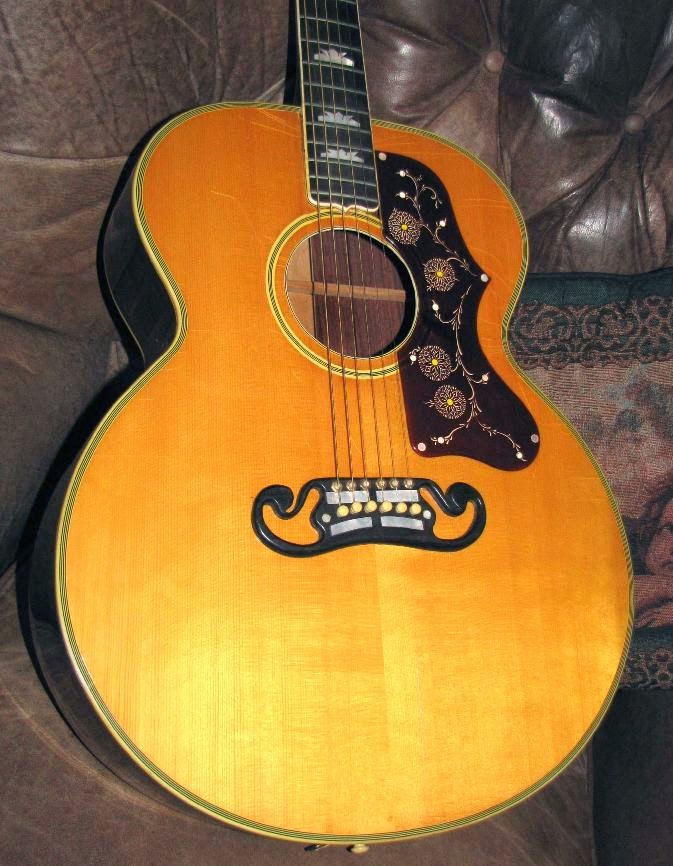The first United States guitars were small "0" sized instrument, strung with gut string. Because of their historical provenance these came to be known as parlor-guitars.
In the early 1930's, the modern guitar became larger and larger as it became a band instrument. Martin produced the first dreadnaught sized instrument.
Gibson was competing with Epiphone and Stromberg to produce a larger archtop guitar, which would better project the instruments voice over the horn and drum section.
 Gibson's concept was similar for flat top guitars. The first models played by Nick Lucas and Robert Johnson were parlor sized Gibson instruments. In an effort to compete with Martin, Gibson moved on to produce the slope shouldered J-50 model. But players wanted louder instruments. Gibson answered the call with the super jumbo model. The first instruments were the SJ-200.
Gibson's concept was similar for flat top guitars. The first models played by Nick Lucas and Robert Johnson were parlor sized Gibson instruments. In an effort to compete with Martin, Gibson moved on to produce the slope shouldered J-50 model. But players wanted louder instruments. Gibson answered the call with the super jumbo model. The first instruments were the SJ-200.This was a top-end instrument with a big booming voice. It is highly prized. The SJ-200's from this era, made of rosewood are prized above newer models.
In 1948 the body depth was increased from 4 1/2" to 4 3/4".
In 1952 the bracing was changed to two X braces, scalloped and projected to the guitars front.
In 1955 the designation was changed from SJ-200 to J-200. The back and sides were made of laminated maple.
In 1961 Gibson added an adjustable bridge and added a large wooden brace that ran under the bridge to the soundhole, which was screwed into the guitar's top.
The neck block extended to the distal edge of the fingerboard.
Perhaps this was done to make the guitar sturdier to decrease warranty work. Who knows? What it did was kill the guitars tone.
In 1963 the neck was changed to a 5 piece laminate. This strengthed the neck.

It resembles an old fashion mustache, turned up on each end. It is made of rosewood. The bridge is highly decorative with mother of pearl or abalone and the strings are held in place by 6 bridge pins in a semi-cirular pattern ensconced by two mother of pearl dots.
Gibson changed the designation from SJ-200 to J-200 in later years. By 1963 the guitar was available with a natural top and maple back and sides that were finished in transparent red stain.
Later in the 1960's the guitar could be ordered with walnut back and sides. The line was discontinued in 1972 only to revived again by the companies new owners.
| Gene Autry |
The list of players who prefer the J-200 is very impressive. Ray Whitley, Emmylou Harris, Roy Rogers, Gene Autry, Gram Parsons, The Everly Brothers, Ike Everly (their father who was a wonderful fingerpicker) and Pete Townshend all play the Gibson J-200 Jumbo Acoustic Guitar.
 |
| Emmylou and Gram Parsons |
Emmylou Harris’s love of Gibson Jumbo acoustics is well documented. She started her career singing duets with country-rock pioneer Gram Parsons. Parsons prefered the J-200 and owned a 1960s model.
Harris still owns this guitar and played it long after Parson's death.
The other is her custom-painted pink J-200 which she used exclusively on her 1985 album, The Ballad Of Sally Rose. Infact, Harris’ career has been distinguished by her close association with Gibson.
In 2002 Gibson has designed a model for her based on the J-200 and named it the Gibson L-200 Emmylou Harris acoustic guitar. This guitar is smaller and thinner than the J-200 model and based on the Gibson CJ-165, only it retains all the fancy aspects of the J-200 model.
Emmylou's L-200
Another model that sprang off from the J-200 was the Everly Brothers guitar.
Phil and Don both were playing J-200's throughout the 1950's when they got their start.
They had customized these with twin pickguards. Based on the Everlys' success Gibson offered them a guitar that would really stand out.
 |
| J-180 Everly Brothers |
In 1963 the Everly model was offered in a natural finish with black pick guards.
The Everly guitar lasted from 1962-1972 before being discontinued until 1986 when it was renamed the J-180. In 1994 it was renamed The Everly Brothers Model.
The construction and quality of gibsons' SJ-200 and J-200 jumbo acoustic guitars during the 40s and early 50s are highly regarded and considered well made instruments.
The instruments from the mid 1950's and 60's are considered somewhat inferior due to Gibson's use of an adjustable bridge and laminated back and sides.
Gibson's current model for the most part has gone back to the original design, but feature gold rotomatic tuners instead of the ususal Waverly models. The guitar also comes equipped with a built-in Fishman Ellipse Aura electronics package. The J-200 is a super instrument that is big, loud and sounds and looks beautiful.
©UniqueGuitar Publishing (for text only)













No comments:
Post a Comment